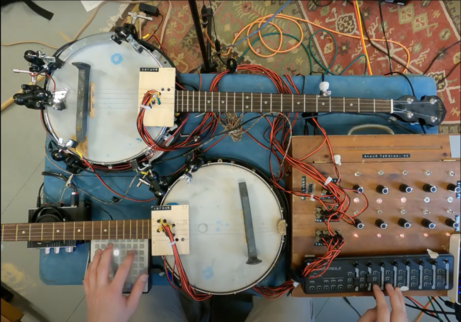Lampo Performance Series: Weston Olencki
@ Graham Foundation for Advanced Studies in the Fine Arts
4 W Burton Pl, Chicago, IL 60610
Opening Saturday, March 11th, at 4PM
In residence at the Madlener House as a Graham Foundation Fellow, Katherine Simóne Reynolds continues her exploration of overhealing from trauma, referencing the creation of a keloid, or hypertropic scar tissue, as an outward representation of healing—a site sensitive to recovery and repair in tandem. Through a new body of work for A different kind of tender and the practice of overhealing, Reynolds looks at the Rust Belt as a kind of keloidal landscape—places in Illinois such as Cairo and Brooklyn, also known as Lovejoy, the first town incorporated by African Americans in the United States in 1873—to reflect on relationships between perceptions of abandonment and fertility, Black female imagination, and different manifestations of healing.
Katherine Simóne Reynolds practice investigates emotional dialects and psychogeographies of Blackness, and the importance of “anti-excellence.” Her work physicalizes emotions and experiences by constructing pieces that include portrait photography, video works, choreography, sculpture, and installation. Taking cues from the midwestern post-industrial melancholic landscape having grown up in the metro east area of Saint Louis, she formed an obsessive curiosity around the practices of healing as well as around a societal notion of progress spurning from a time of industrial success. Utilizing Black embodiment and affect alongside her own personal narrative as a place of departure has made her question her own navigation of ownership, inclusion, and authenticity within a contemporary gaze. She draws inspiration from Black glamour and beauty while interrogating the notion of “authentic care.” Her practice generally deals in Blackness from her own perspective, and she continuously searches for what it means to produce “Black Work.”
Reynolds has exhibited and performed work within many spaces and institutions including the Pulitzer Arts Foundation; The Museum of Modern Art; and SculptureCenter. She has exhibited in national and international group and solo shows, has spoken at the Contemporary Art Museum of Saint Louis, the Saint Louis Art Museum, and the Black Midwest Initiative Symposium at University of Minnesota. Alongside her visual art practice, she has embarked on curatorial projects at The Luminary; SculptureCenter; and upcoming exhibitions for Stanley Museum of Art as well as Clyfford Still Museum.
ABOUT THE FELLOWSHIP
Synthesizing the Foundation’s grantmaking and exhibition programs, the program acknowledges the investment and resources required to produce an exhibition and invites an artist to create new work that engages the mission of the Graham Foundation—to explore ideas about architecture and its role in the arts, culture, and society. Providing space, support, and financial resources for the production of new work, the Fellowship enables the Fellow to experiment with production techniques and, often, to create work at a new scale. The Fellowship culminates with an exhibition at the Foundation’s Madlener House galleries in Chicago.
The Fellowship program extends the legacy of the Foundation’s first awards, made in 1957, and continues the tradition of support to individuals to explore innovative perspectives on spatial practices in design culture. These initial fellowships provided a diverse group of practitioners a platform to pursue innovative ideas in the field, and they included alumni such as experimental architect Frederick J. Kiesler, painter Wilfredo Lam, Pritzker Prize winning architects Balkrishna V. Doshi and Fumihiko Maki, designer Harry Bertoia, photographer Harry M. Callahan, and sculptor Eduardo Chillida, among others. Artist David Hartt piloted the contemporary Fellow program with his new body of work in the forest, which premiered at the Graham in the fall of 2017. Additional Graham Foundation Fellows include: Brendan Fernandes (2018); Torkwase Dyson (2018); Martine Syms (2018–19); Nelly Agassi (2019); Tatiana Bilbao (2019–20); Sergio Prego (2020); Anna Martine Whitehead (2020–21); Barbara Stauffacher Solomon (2022–23); and Mark Wasiuta (forthcoming)
Official Website
More events on this date
Tags: Chicago, Graham Foundation, Lampo Performance Series, Near Norths Side, Weston Olencki

« previous event
next event »